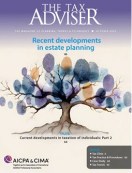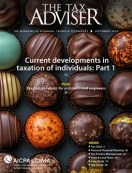- tax clinic
- FOREIGN INCOME & TAXPAYERS
IRS FAQ clarifies sunset of Notice 2010-46 credit forward framework
Related
IRS ruling clarifies treatment of R&D when computing the FDII deduction
Global tax deal could hurt US companies, says letter requesting OECD guidance
AI is transforming transfer pricing
Editor: Susan M. Grais, CPA, J.D., LL.M.
On Sept. 12, 2024, the IRS updated its frequently asked questions (FAQs) on general compliance with Foreign Account Tax Compliance Act (FATCA) rules with a new FAQ 26 answer, which states that withholding agents, including those that previously used the “credit forward” framework, may not use it after Dec. 31, 2024.
Notice 2010-46 had provided a credit forward framework to address the problem of overwithholding on a chain of dividends and dividend equivalents. While the IRS intended to sunset Notice 2010-46 as part of the regulations under Sec. 871(m), subsequent transition notices under that section resurrected parts of Notice 2010-46, and some withholding agents asserted that the credit forward framework survived, as it was still referenced in the IRS instructions to Form 1042, Annual Withholding Tax Return for U.S. Source Income of Foreign Persons.
Background
If the owner of a security lends the security to another person under a securities-lending agreement or borrows against it in a sale-repurchase agreement (repo transaction), and a payment, such as a dividend, is made while the security is out on loan or repo, the agreement typically requires the securities borrower or repo lender to make an equivalent payment (a “substitute” payment) to the securities lender or repo borrower.
People usually borrow securities to sell them short, cover a transaction where someone else failed to deliver a security, or relend them to someone else. Thus, such borrowers typically do not hold the security when a substitute payment is due and must make the payment out of their own pocket. In a few cases, however, borrowers will in fact own the security on the record date for the payment and receive a payment from the issuer, which the borrowers will then pass on as a substitute payment.
Since 1997, Treasury regulations have provided that substitute payments have the same character, source, and treatment for cross-border and treaty purposes as the underlying payments would have (Regs. Secs. 1.861-2(a)(7), 1.861-3(a)(6), 1.864-5(b) (2)(ii), 1.871-7(b)(2), 1.881-2(b)(2), and 1.894-1(c), as promulgated by T.D. 8735, 62 Fed. Reg. 53498 (Oct. 14, 1997)). Because a single security might go through a chain of loans (e.g., A lends the security to B, who lends it to C, who lends it to D, who sells it short), concerns were raised that a single substitute payment might go through several hands and be subject to withholding at each step and that the cumulative withholding might exceed the statutory maximum of 30%.
To avoid excess cascading withholding, Notice 2010-46 introduced two forms of relief. First, it established the qualified securities lender (QSL) regime, under which QSLs receive substitute payments gross but generally are obligated to withhold when they pay on the amounts. Second, it provided for a “credit forward system.” If a withholding agent (other than a QSL), who was entitled to receive substitute dividends gross, paid a substitute dividend to a foreign person, the withholding agent could reduce the withholding on the payment by the tax previously withheld within the same series of transactions, if there was sufficient proof of upstream withholding.
Notice 2010-46 was obsoleted as of Jan. 1, 2018, with the promulgation of the Sec. 871(m) regulations in 2017. However, under a series of notices deferring the effective date of the Sec. 871(m) regulations (e.g., Notices 2022-37 and 2024-44), withholding agents could continue to apply the QSL regime through 2026. Starting in Notice 2022-37, the extension references cited that only the QSL section of Part III was extended, which excluded the credit forward regime. The instructions to Form 1042, however, continued to instruct withholding agents on how to report when credit forward was applied. Because of this, some practitioners believe that it was unclear whether the credit forward provisions could also be used under the subsequent notices.
FAQ 26
In FAQ 26, the IRS clarifies that the credit forward provisions of Notice 2010-46 may no longer be used, even though the QSL regime from Notice 2010-46 was extended through 2026. However, due to confusion as to whether the credit forward provisions continue to apply, the IRS said it will not challenge withholding agents that have used the credit forward framework described in Notice 2010-46 for periods preceding Jan. 1, 2025, provided they were using the credit forward framework before the FAQ answer’s release. Withholding agents that were not previously using the credit forward framework could not begin to use that framework after Sept. 10, 2024. These clarifications will also be made in the Form 1042 instructions.
Observations
Even when QSL status is represented, withholding agents may still apply withholding on the payment, making credit forward a useful tool for all withholding agents, including QSLs. Presumably, with the loss of the credit forward system, QSLs may still claim a credit for withholding applied upstream but will need to wait for the refund following the processing of their Form 1042. Other withholding agents will need to consider qualified intermediary (QI) or qualified derivatives dealer (QDD) status to avoid withholding, which can be a costly endeavor as the IRS continues to enhance those statuses’ compliance obligations.
For these reasons, it is surprising that the IRS ended the regime via an FAQ without providing an opportunity to comment, as the industry has submitted many comments around its concerns on how the QDD regime is unworkable for a withholding agent that engages solely in securities-lending transactions.
Editor Notes
Susan M. Grais, CPA, J.D., LL.M., is a managing director at Ernst & Young LLP in Washington, D.C. For additional information about these items, contact Grais at susan.grais@ey.com. Contributors are members of or associated with Ernst & Young LLP.
The views expressed are those of the authors and are not necessarily those of Ernst & Young LLP or other members of the global EY organization. This information is provided solely for the purpose of enhancing knowledge on tax matters. It does not provide accounting, tax, or other professional advice.














